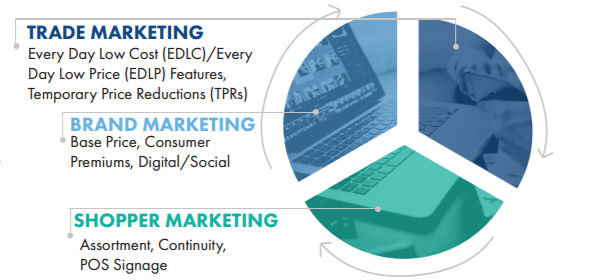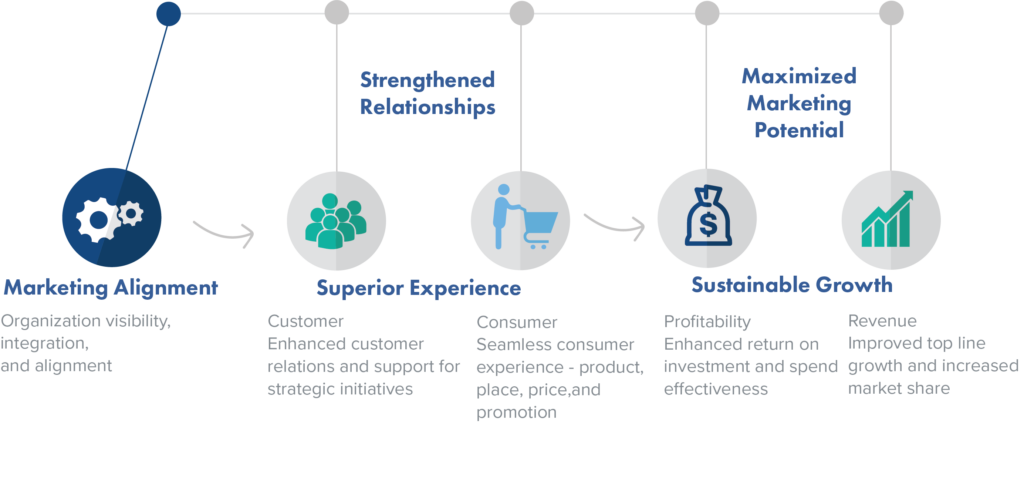Aligning Sales & Marketing Investments to Achieve Growth in Consumer Products
Consumer products manufacturers have long struggled to find the optimal combination of trade, shopper, and brand marketing investments. While the goal of optimizing marketing investments has been a priority for decades, this has become increasingly challenging due to the rise of digital marketing, the growing number of marketing and promotional tactics, and the changing dynamics of consumers and the retail shopping experience.
Our Holistic Marketing Alignment experts share their perspectives on why it’s important for consumer products companies to align sales and marketing and manage all marketing investments as one budget.
Download the Sales & Marketing Alignment PDF Here
The Opportunity for Consumer Products
Consider the following: A typical consumer products (CP) manufacturer with $1 billion in annual sales will, on average, invest approximately $200 million on trade marketing activities and, approximately, $100 million on traditional brand marketing activities. We have found that by rooting out organizational barriers that cause misalignment between marketing and sales, managing marketing investments holistically, and better leveraging analytical tools and capabilities, a typical $1B CP manufacturer could reasonably expect to:
- Achieve incremental financial benefit of $5 – $15M per year
- Accelerate net revenue growth up to a 20% increase
- Improve operating margins up to a 15% increase
So how can companies capitalize on this opportunity? The answer is through Holistic Marketing Alignment.
What is Holistic Marketing Alignment?
Clarkston Consulting’s Holistic Marketing Alignment approach helps CP organizations recognize which levers to pull and which tactics to deploy across marketing investments, create greater transparency across sales and marketing functions, and capitalize on shifting retailer and consumer expectations. The following three principles that include the importance of integration through organization strategy, process excellence through repetition, and visibility through analysis and analytics.

1. Organizational Strategy
The first step to drive greater alignment across all elements of your spend is to truly understand the full complement of trade-offs, risks, and opportunities around marketing mix and marketing investment allocation decisions.
This is enabled, first and foremost, by the ability to view and treat marketing investments ‘holistically’ as a single budget. This will allow for the ability to allocate spend on a more granular basis and better match investment across competing sales and marketing opportunities.
Essentially, organizations should become more proactive with their investment planning, execution, and measurement for sales and marketing spend in total and combine that with better, faster decision-making at the right level in the organization.
Managing marketing resources ‘holistically’ is the first step. CP organizations should remove ingrained barriers that block cross-functional alignment and focus on building the key capabilities below.
- A consumer-centric strategy
- The right organizational design and integrated processes to harmonize sales and marketing
- The right structure and processes to integrate sales and marketing with other functions and organizational processes
- Agile decision-making processes to redirect marketing investments
- The right institutional skills and capabilities to link sales and marketing strategy with execution
- The right incentives and reward systems to promote alignment
- A measurement culture supported by the right Key Performance Indicators (KPIs)
2. Operational Excellence
Process excellence has long driven manufacturing and supply chain practices to strive towards near-perfect quality outputs. CP organizations should apply a similar disciplined process to the full cycle of managing marketing investments in totality. Once the executive level is aligned and stakeholders are set up to make better informed decisions, a commitment to a process framework that is clear, repeatable, and measurable is necessary for continual improvement.
The integration of information flow between the sales and marketing groups is a condition for effective demand reviews within the broader context of integrated business planning. Reaching shoppers and consumers through understanding customer and consumer needs, beliefs, and behaviors is challenging marketers and sales professionals in ways previously not imagined.
To help overcome this challenge, CP organizations should adopt a planning process known as ‘Holistic Marketing Cycle Planning,’ which consists of regular gates to optimize initial investment planning followed by a cadence of periodic sales and marketing performance reviews. Periodic reviews allow for the early identification and amplification of successful initiatives across sales and marketing as well as timely course correction for under-performing ones.
3. Analytics Proficiency
Visibility into marketing performance through precise measurement and analytics across media and sales channels is the other critical component for accelerating growth using marketing levers. CP organizations must determine what information is most important and interpret what it means across functions to shape marketing strategic planning all the way to execution. From there, CP organizations should use an insights-based dashboard to monitor business impacts and related costs of marketing investments. The dashboard acts as a hub that reflects leading and lagging key performance indicators. This lends much greater objectivity to all marketing investment decisions while helping drive intended performance.
One more point: we realize that insights begin with talented people probing into thoughtful questions. That is, data and tools alone will not provide answers. But when an organization is aligned and committed to Holistic Marketing conceptually, with processes designed to execute with excellence, and people have the right data and tools to do their jobs well, then… optimal value is within reach.
Aligning Sales & Marketing for Growth
CP organizations should thoughtfully consider these questions given today’s growth challenges.
- Do we have the right marketing strategy to maximize demand generation, drive revenue growth, and achieve profit targets
- Do we have the right mix of sales and marketing investments?
- Do we have the right sales and marketing structure and ways of working for alignment and cross-functional integration?
- Do we have the right business processes, technologies, and tools for operational excellence?
- Do we have the right data strategy and analytics proficiency to drive insights generation?

Learn more about Holistic Marketing Alignment or download the report below.
Download the Sales & Marketing Alignment PDF Here
This perspective was co-authored by: Steve Rogers.



